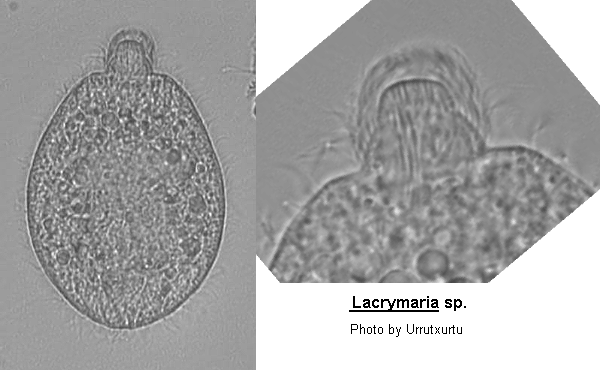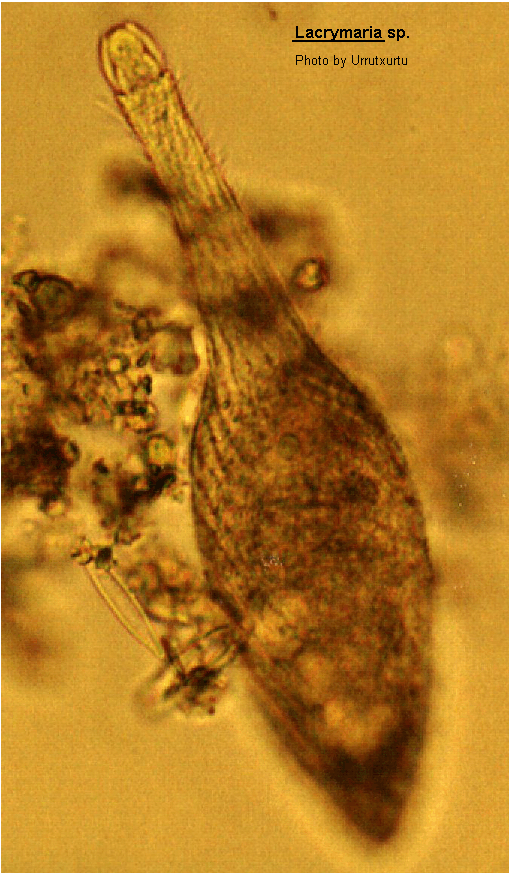Lacrymaria
Lacrymaria Bory, 1826 (ref. ID; 2013) or Ehrenberg, 1830 (ref. ID; 3540, 3690) reported year? (ref. ID; 1618)

Class Kinetofragminophora de Puytorac et al., 1974: Order Haptorida Corliss, 1974 (ref. ID; 4893) [ref. ID; 2013]
Body shape changeable due to contractility, varies from ovoid to cylindrical to flask-like with long anterior extensible neck region upon which there is a snout-like region consisting of two zones. The apical zone is unciliated and demarks the area which carries the temporary oral aperture when present. The zone nearer the neck is ciliated with long cilia which arise from many short oblique kineties. The posterior end of the cell may be broadly rounded or may narrow to a blunt point. The cell is completely covered by uniform cilia (shorter than those on the snout) which arise from longitudinal or spiral kineties. The somatic kinetosomes may be paired at the anterior end of the body in some species. Macronucleus in 1, 2 or rarely in several parts. Contractile vacuole on posterior body region.
Quote; Colin R. Curds "British and other freshwater ciliated protozoa Part I Ciliophora: Kinetofragminophora" Cambridge University Press, 1982 (ref. ID; 2013)
- Lacrymaria aciformis Kahl, 1933 (ref. ID; 1620)
- Lacrymaria acuta Kahl, 1933 (ref. ID; 1620, 3690)
- Lacrymaria aquae dulcis (Roux, 1901) Lauterborn, 1915
See; Lacrymaria pupula (ref. ID; 1619) - Lacrymaria balechi Dragesco (ref. ID; 3690)
- Lacrymaria caspia Grimm, 1876
See; Lacrymaria coronata Claparede & Lachmann, 1858 (ref. ID; 1619, 3540) - Lacrymaria caudata Kahl, 1932 (ref. ID; 3690) or 1933 (ref. ID; 1620, 2117, 3119)
- Lacrymaria caudata Kahl var. lemani Dragesco, 1960 (ref. ID; 3690 original paper)
- Lacrymaria cohni Kent, 1881 (ref. ID; 1619, 1620, 3540)
- Lacrymaria conifera Burkovsky, 1970 (ref. ID; 2112 original paper)
- Lacrymaria coniformis Burger, 1908 (ref. ID; 1619, 3540)
- Lacrymaria coronata Claparede & Lachmann, 1858 (ref. ID; 1619, 1890, 2117, 2245, 2316, 3540) or 1859 (ref. ID; 4730) reported year? (ref. ID; 1618, 3690)
See; Phialina coronata (ref. ID; 4730)
Syn; Lacrymaria caspia Grimm, 1876 (ref. ID; 1619, 3540) - Lacrymaria coronata var. aquae dulcis Roux, 1901
See; Lacrymaria pupula (ref. ID; 1619) - Lacrymaria cucumis Penard, 1922 (ref. ID; 1619, 3540, 4730)
See; Lagynus cucumis (ref. ID; 4730)
Syn; Lacrymaria putrina Kahl, 1926 (ref. ID; 1619) - Lacrymaria cupifera Kahl, 1933 (ref. ID; 1620)
- Lacrymaria delamarei Dragesco (ref. ID; 3690)
- Lacrymaria elegans Engelmann, 1862 (ref. ID; 1619, 3540) reported author and year? (ref. ID; 7689)
See; Lagynus elegans Quennersted, 1867 (ref. ID; 4612)
Syn; Lagynus elegans Quennersted, 1867 (ref. ID; 1619, 3540, 4347, 4612) - Lacrymaria elliptica Burger, 1908
See; Lacrymaria pupula (ref. ID; 1619, 3540) - Lacrymaria filiformis Maskell (ref. ID; 3698)
- Lacrymaria kahli Dragesco (ref. ID; 3690)
- Lacrymaria lagenula Claparede & Lachmann, 1858 (ref. ID; 1619, 2117, 3540) reported year? (ref. ID; 1618)
- Lacrymaria marina Kahl, 1933 (ref. ID; 3119) reported author and year? (ref. ID; 1890)
- Lacrymaria marinum Kahl, 1933 (ref. ID; 4893)
- Lacrymaria metabolica Burger, 1908
See; Lacrymaria vermicularis O.F. Muller-Ehrenberg, 1831 (ref. ID; 1619, 3540) - Lacrymaria minima Kahl, 1927 (ref. ID; 1619, 3540)
- Lacrymaria olor O.F. Muller, 1776 (ref. ID; 1219, 1335, 1619, 1629, 1896, 2245, 3115, 3540) or 1786 (ref. ID; 7579) reported year? (ref. ID; 1618, 5462, 7558), (Mueller, 1786) Bory de Saint-Vincent, 1824 (ref. ID; 4488, 4612) reported author and year? (ref. ID; 191, 7689)
Syn; Lacrymaria proteus (ref, ID; 3115); Trachelocerca filiformis Maskell, 1886 (ref. ID; 3540); Vibrio olor O.F. Muller, 1786 (ref. ID; 4612) - Lacrymaria olor var. marina Kahl, 1933 (ref. ID; 1620, 3690)
- Lacrymaria proteus Ehrenberg, 1830
See; Lacrymaria olor (ref. ID; 3115) - Lacrymaria phialina Svec, 1897
See; Lacrymaria vermicularis Muller-Ehrenberg, 1831 (ref. ID; 3540) - Lacrymaria phialina Svec, 1907
See; Lacrymaria pupula (ref. ID; 1619) - Lacrymaria phyalina Penard, 1922
See; Lacrymaria pupula (ref. ID; 1619) - Lacrymaria pulchra Wenzel, 1953 (ref. ID; 3593 original paper)
- Lacrymaria pumilio Vuxanovici (ref. ID; 3698)
- Lacrymaria pupula O.F. Muller, 1786 (ref. ID; 1619, 3540) reported year? (ref. ID; 3690)
Syn; Lacrymaria aquae dulcis (Roux, 1901) Lauterborn, 1915 (ref. ID; 1619); Lacrymaria coronata var. aquae dulcis Roux, 1901 (ref. ID; 1619); Lacrymaria elliptica Burger, 1908 (ref. ID; 1619); Lacrymaria phialina Svec, 1907 (ref. ID; 1619); Lacrymaria phyalina Penard, 1922 (ref. ID; 1619); Lacrymaria striata Gulati, 1926 (ref. ID; 1619) - Lacrymaria pusilla (Claparede & Lachmann) (ref. ID; 5624)
- Lacrymaria putrina Kahl, 1926
See; Lacrymaria cucumis (ref. ID; 1619, 3540) - Lacrymaria rostrata (ref. ID; 1620)
- Lacrymaria rotundata Dragesco (ref. ID; 3690)
- Lacrymaria salinarum Kahl, 1928 (ref. ID; 1619, 3540)
- Lacrymaria sapropelica Kahl, 1927 (ref. ID; 1619, 3540) reported author and year? (ref. ID; 4612)
- Lacrymaria spiralis Corliss & Snyder, 1986 (ref. ID; 7603 original paper)
- Lacrymaria spiralis Kahl, 1926
See; Lacrymaria vermicularis O.F. Muller-Ehrenberg, 1831 (ref. ID; 1619, 3540) - Lacrymaria striata Gulati, 1926
See; Lacrymaria pupula (ref. ID; 1619, 3540) - Lacrymaria trichocystus Dragesco (ref. ID; 3690)
- Lacrymaria truncatum Stokes, 1885
See; Spathidium truncatum - Lacrymaria urnula Kahl, 1930 (ref. ID; 3540 original paper) reported author and year? (ref. ID; 1619)
- Lacrymaria vermicularis O.F. Muller, 1786 (ref. ID; 3593) or O.F. Muller-Ehrenberg, 1831 (ref. ID; 1619, 3540)
Syn; Lacrymaria metabolica Burger, 1908 (ref. ID; 1619, 3540); Lacrymaria phialina Svec, 1897 (ref. ID; 1619, 3540); Lacrymaria spiralis Kahl, 1926 (ref. ID; 1619, 3540); Phialina viridis Ehrenberg-Claparede, 1858 (ref. ID; 1619, 3540) - Lacrymaria versatilis Quennerstedt, 1867 (ref. ID; 1619, 1620, 3540)
- Lacrymaria vertens Stokes, 1885 (ref. ID; 1619, 3540)
Lacrymaria coronata Claparede & Lachmann, 1858 (ref. ID; 1619, 1890, 2117, 2245, 2316, 3540) or 1859 (ref. ID; 4730) reported year? (ref. ID; 1618, 3690)
See
Phialina coronata (ref. ID; 4730)Synonym
Lacrymaria caspia Grimm, 1876 (ref. ID; 1619, 3540)Descriptions
Large; neck extensible; body form variable, but usually with bluntly rounded posterior end; endoplasm appears dark; striae spiral; salt and brackish water. (ref. ID; 1618)Body slim, with distinctive tail, but could not be confused with L. caudata Kahl, 1933. Refractile granules filled anterior of cell; single contractile vacuole at the posterior. Single large macronucleus. (ref. ID; 2316)
Measurements
85-100 um long. (ref. ID; 1618)Mean length 130 um. (ref. ID; 2316)
Lacrymaria lagenula Claparede & Lachmann, 1858 (ref. ID; 1619, 2117, 3540) reported year? (ref. ID; 1618)
Descriptions
Body flask-shape; neck highly extensible; striation distinct, spiral when contracted; macronucleus short sausage-like or horseshoe-shape; endoplasm granulated; salt water. (ref. ID; 1618)Measurements
Body 70 um long, up to 150 um. (ref. ID; 1618)Lacrymaria olor O.F. Muller, 1776 (ref. ID; 1219, 1335, 1619, 1629, 1896, 2245, 3115, 3540) or 1786 (ref. ID; 7579) reported year? (ref. ID; 1618, 5462, 7558), (Mueller, 1786) Bory de Saint-Vincent, 1824 (ref. ID; 4488, 4612) reported author and year? (ref. ID; 191, 7689)
Synonym
Lacrymaria proteus (ref, ID; 3115); Trachelocerca filiformis Maskell, 1886 (ref. ID; 3540); Vibrio olor O.F. Muller, 1786 (ref. ID; 4612)Descriptions
Body elongated, flask-shaped with a long and highly contractile proboscis anteriorly, very polymorphic, body ciliation rather short and dense; a circle of longer cilia is present at the head-like anterior part of the proboscis, which is marked by a ring-like constriction; cytostome at anterior pole, supported by trichites, 2 spherical macronuclei and a single micronucleus between them; 2 contractile vacuoles. (ref. ID; 1219)Elongate; highly contractile; two macronuclei; two contractile vacuoles; when dividing, long neck is formed sidewise so that it appears as oblique division (Penard), however, Bovee (1957) noted the division transverse; fresh and salt water. (ref. ID; 1618) Feeding behavior: The usual feeding behaviour of Lacrymaria is observed when the body of the animal is anchored in debris and the neck is free to extend into the surrounding medium. The neck extends and retracts in all directions apparently at random for a few minutes until either a food organism is located or the animal retracts its neck and remains quiescent for some minutes before repeating the searching activity again. Whether a prey organism was struck by a static or a swimming individual a similar sequence of events was observed. The first action after contact was the discharge of a number of toxicysts from the apical dome. The prey organism is usually paralysed by this attack although some may be able to tear themselves free and escape. This is often the case if the animal is larger than the Lacrymaria, for example, Stentor coeruleus, although prolonged exposure to Lacrymaria in large numbers eventually leads to the death of the Stentor and a number of Lacrymaria will participate in its consumption. As soon as the toxicysts have been discharged and are holding a small prey organism the behaviour of the neck changes and it becomes rigid and is maintained at the length at which it was at the moment of toxicyst discharge (Tatchell 1980). The second event is the opening of the cytostome. This process takes place by the expansion of the ciliated crown and the collapse of the oral dome into the cavity created. Thus the pellicle of the dome becomes the lining of the first part of the cytostome. During this process the toxicysts sink down as the floor of the cytostome descends into the neck and thus the prey is drawn into the cytostome. When large organisms are engulfed, the neck may contract drawing the body of the Lacrymaria towards the prey and the process of food vacuole formation takes 2-3 minutes instead of only a few seconds. Once the food vacuole has been formed the cytostome reverts to its usual form as the oral dome reestablishes itself. The food vacuole then passes down the neck of the Lacrymaria. In the case of the ingestion of small organisms the neck may extend during this process and so the vacuole forms a swelling which gradually moves down the neck. The passage of the food vacuole down the neck of the body of the Lacrymaria may take up to thirty seconds although on some occasions it takes only two or three seconds. When larger organisms or fragments are ingested the neck is usually retracted and the food vacuoles is passed directly into the body of the animal. As a rule the Lacrymaria does not resume feeding immediately after a large meal and may even divide before the resumption of feeding behavior. Lacrymaria has ben observed feeding on a variety of protozoan organisms, species of the following genera being most commonly taken: - Entomonas, Cryptomonas, Chilomonas, Cyclidium, Halteria, Vorticella and a small amoebae. The oral region of Lacrymaria consists of two main structure, the ciliated crown and the apical dome (Didier and Bohatier 1970 and Bohatier 1970). Further details are described in this paper. (ref. ID; 7558)
Measurements
Length 400 um (When fully extended, up to 1.2 mm). (ref. ID; 1219)Extended forms 400-500 um up to 1.2 mm. long. (ref. ID; 1618)